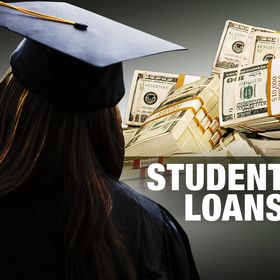Genius Hacks to Demolish Student Loan Debt , FAFSA , and portion of loan forgiveness
Welcome to a financial transformation! If you’re navigating the maze of student loan debt, you’re not alone. In this comprehensive guide, we unveil the strategic secrets to not just manage, but conquer your student loans. Get ready to embark on a journey toward financial freedom as we decode the SEO-friendly tactics that will empower you to break free from the shackles of student debt. Let’s turn your financial dreams into reality!

#What are the best Student Loans? Schemes based on ROI:
While applying for your student loan you should do good research on which loan providers are best for the particular student loan. Keeping in mind the interest rate should be low and the tenure on the return on investment should be appropriate for all citizens. So here are well-researched some of the best student loan providers in the US…
- collegeave student loan: it is a choice because it has a disbursement fee of 0% and a fixed low-interest rate of 6.78% with 6.45%APR 2. credible student loan: It is again a good student loan scheme and the most beautiful thing about this loan is that it doesn’t need any credit cheque from its customers. 3. ascent student loan : This type of loan is so well made it gives a 1% Cash Back on the principle loan amount at graduation. It gives a maximum loan of 200,000$. 4. Sofi student loan: This is one of the best kind of student loan which is famous for No Fees student loan.
#How Do I Fill Out a FAFSA Form
- Gather Information:
- Social Security number or Alien Registration number (if you’re not a U.S. citizen)
- Federal income tax returns, W-2s, and other records of money earned (for you and your parents, if applicable)
- Bank statements and records of investments (if any)
- Records of untaxed income (if applicable)

- Create an FSA ID:
- Go to the FSA website (studentaid.gov) to create your FSA ID. This will serve as your electronic signature.
- Start the FAFSA Application:
- Go to fafsa.gov and log in using your FSA ID.
- Choose the correct academic year you’re applying for.
- Personal Information:
- Provide your personal information, including your name, date of birth, and Social Security number.
- School Selection:
- Add the school codes for the colleges you’re interested in. You can find these codes on the FAFSA website.
- Dependency Status:
- Answer questions to determine if you’re a dependent or independent student. This affects whose financial information you need to provide.
- Parental Information:
- If you’re a dependent student, provide your parents’ financial information. This includes tax returns and other income information.
- Student Financial Information:
- Enter your own financial information, including income and assets.
- Sign and Submit:
- Review your information carefully, make any necessary corrections, and sign your FAFSA electronically using your FSA ID.
- Submit the form.
- Confirmation:
- You’ll receive a confirmation page and a confirmation email. Review the information to ensure accuracy.
#FEDERAL LOANS AVAILABLE
Here are different types of federal student loans available in the USA….
- Direct Subsidized Loans:
- These loans are based on financial need. The government pays the interest on the loan while you’re in school at least half-time, during the grace period after you leave school, and during any deferment periods.
- Direct Unsubsidized Loans:
- These loans are not based on financial need, and you’re responsible for paying the interest on the loan during all periods. You can choose to pay the interest while you’re in school or allow it to accrue and be capitalized (added to the principal amount of the loan).
- Direct PLUS Loans:
- These loans are for graduate or professional students and parents of dependent undergraduate students. They help pay for education expenses not covered by other financial aid. PLUS Loans require a credit check, and the borrower is responsible for paying the interest.
- Perkins Loans:
- Perkins Loans were a federal student loan program, but it has expired, and no new loans are being made under this program. Existing Perkins Loan borrowers still need to repay their loans according to the terms of the promissory note.
Are there loan forgiveness programs?
- Public Service Loan Forgiveness (PSLF):
- Eligibility: To qualify, borrowers must work for a qualifying public service organization, be on an income-driven repayment plan, and make 120 qualifying monthly payments while employed full-time.

-
- Forgiveness: After 120 qualifying payments (10 years), the remaining balance on the Direct Loans may be forgiven tax-free.
- Teacher Loan Forgiveness:
- Eligibility: Designed for teachers working in low-income schools. To qualify, teachers must teach full-time for five consecutive years in a qualifying school.
- Forgiveness: Eligible teachers can receive forgiveness of up to $17,500 on their Direct Subsidized and Unsubsidized Loans or Subsidized and Unsubsidized Federal Stafford Loans.
<5 PRO TIPS>
- Develop a detailed budget to understand your income, expenses, and areas where you can cut back. Allocate a significant portion of your income to loan payments.
- If you have multiple student loans, focus on paying off the ones with the highest interest rates first. This minimizes the overall interest paid.
- Some employers offer student loan repayment assistance as part of their benefits. Check if your employer provides such programs and take advantage of them.
- Consider taking on a part-time job or freelancing to supplement your income. Use the additional earnings to make extra loan payments.
- Cut unnecessary expenses and adopt a frugal lifestyle. Redirect the money saved towards your student loan payments.
If you want to get such premium content on finance money topics subscribe and visit —————>>>> thefinancepay.com